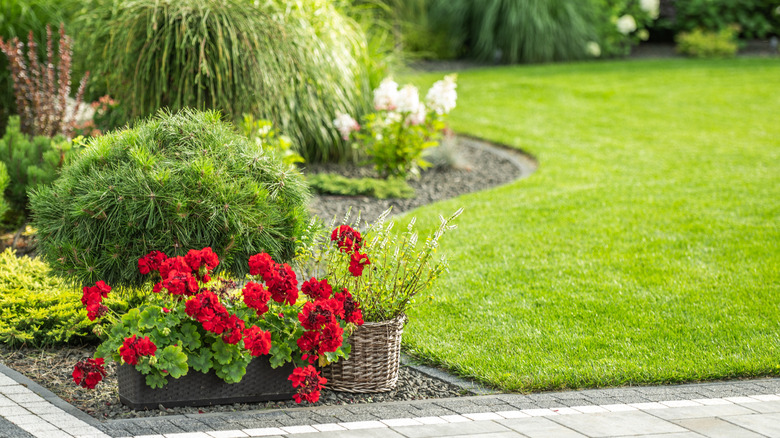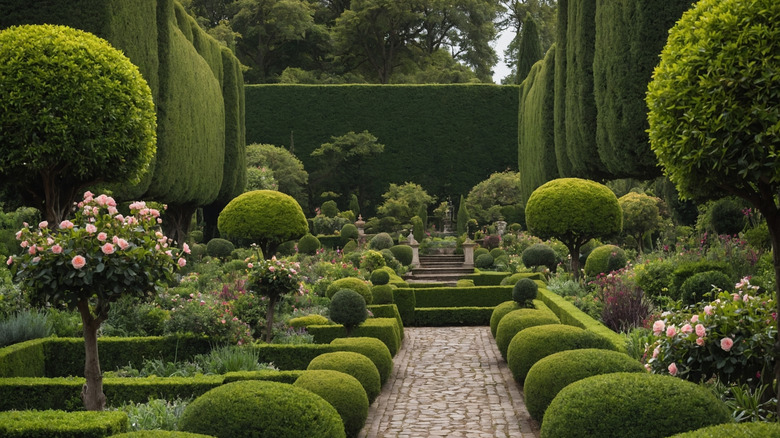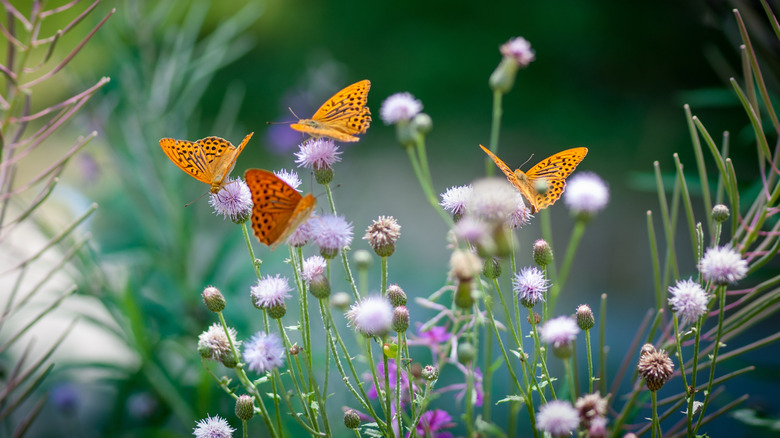Your Garden Borders Are More Of A Statement Piece Than You Think
Garden borders (called herbaceous borders in England) are garden spaces that are traditionally edged by a wall, fence, patio, or other structure, or a house or building, and can only be viewed from one angle (usually straight on). This differentiates them from stand-alone garden or flower beds that are potentially viewable from all sides. These structural border spaces are wonderful garden spots for exploring design options that can make a statement, expressing the personality and style of the gardener.
There are two basic approaches to designing garden spaces: formal and informal, with many variations (including cottage gardens, wildlife gardens, pollinator gardens, and contemplation or meditation gardens). Following guidelines for these approaches, plus adding your own special flair, will help you create a garden that reflects you, the gardener, and your love of plants, nature, and growing things. Gardens can be very visually-appealing places, and also spaces that fulfill certain functions, like growing food, providing a secluded spot for reading or resting, or making an inviting space for entertaining guests.
Whether you want your garden to demonstrate your expertise in horticulture, your favorite colors, your love of fragrant flowers, your whimsical taste in thrift shop finds, or your ability to make a stunning visual design, there are infinite ways to express your identity as a gardener with your garden border. You need not spend a lot of money to create a unique and appealing garden space, but keep in mind that most gardens will require a certain amount of work to get established and will require regular maintenance.
Formal vs. informal garden design
Formal gardens are often associated with a romantic vision of the past, like the grand gardens seen in historical films, surrounding vast English country estates, or large chateaus in France. These garden borders are often characterized by geometric shapes, symmetry, carefully tended plants, and closely clipped hedges or topiary. Formal gardens make a statement of perfection and orderliness — qualities that can take a great deal of upkeep. While symmetrical design elements are perhaps the most obvious expression of a formal look, this approach is considered an outdated trend for today's gardens.
Because formal gardens are not only somewhat old-fashioned but also challenging to maintain, many modern gardeners opt for a more casual, informal look. The rigid expectations of formal gardens become more relaxed: an informal garden border may feel less intentional, more whimsical, with more curves and fewer angles. There are still design elements in play, however: balancing sizes, shapes, textures, and colors, and adding non-plant elements such as walkways, fences, water features, or arbors.
There are some design principles that apply to all garden spaces. For example, most garden borders have taller flowers and plants in back and shorter ones in front for maximum visibility, but this can depend on the shape of the border, which might be straight, curved, or L-shaped. Also, most borders will have several anchor plantings in the form of shrubs or maybe small trees, depending on the size of the space, to provide a sense of flow. But beyond these basics, the principles that govern informal garden designs are fairly open-ended, especially when it comes to color or shapes.
Nature-based garden borders
Informal gardens might be a relaxed gardening trend that's replacing more formal landscapes, but they can still intentionally express the personality of the gardener or designer. These approaches could include a cottage garden or a contemplation garden. Cottage gardens tend to be in bloom through three seasons: they often have many different plants, large clumps of perennials that provide large blocks of color, and an array of textures and shapes. A cottage garden reflects an approach to gardening that shows an appreciation for beauty and the excitement of combining different plants in the border to create a pleasing and eclectic design.
A contemplation garden is one designed to evoke a feeling of peace and serenity. Such a space might emulate a Japanese meditation garden, which follows certain principles of nature and the elements in harmony. While there is a certain feeling of formality to these kinds of gardens, they are also spaces of subtle beauty, meant more to soothe the mind and spirit than to create an impression. This approach can be both very intentional and simple, and can be applied to even a small garden border.
Other approaches to border design have nature as a guiding principle, such as pollinator gardens, wildlife gardens, or gardens intended to increase biodiversity. Garden borders with these priorities demonstrate a desire to work alongside nature and to appreciate the different living creatures that live in and near the garden, including insects, birds, and other wildlife. A natural approach to gardening communicates a deep involvement with horticulture, blending personal enjoyment with a sense of accomplishment and a constant opportunity to learn from nature.


